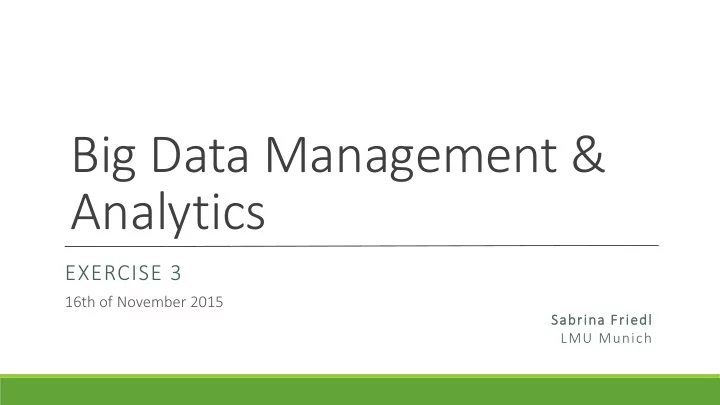

Big Data Management & Analytics EXERCISE 3 16th of November 2015 Sabrina Friedl LMU Munich
1. Revision of Lecture PARALLEL COMPUTING, MAPREDUCE
Parallel Computing Architectures • Required to analyse large amounts of data • Organisation of distributed file systems Replicas of files on different nodes Master node with directory of file copies Examples: Google File System, Hadoop DFS • Goals Fault tolerance Parallel execution of tasks
MapReduce - Motivation MapReduce: Programming model for parallel processing Big Data on clusters • Stores data that can be processed together close to each other/close to worker (Data Locality) • Handles data flow, parallelization and coordination of tasks automatically • Copes with failures and stragglers
MapReduce – Processing (High Level) Master Assign Assign map tasks reduce tasks
MapReduce – Programming Model Transform set of input key-value pairs into set of output key-value pairs • Step 1 : map(k1, v1) -> list(k2, v2) • Step 2 : sort by k2 -> list(k2, list(v2)) • Step 3 : reduce(k2, list(v2)) -> list(k3, v3) -> Programmer specifies map() and reduce() function
MapReduce – Word Count Partition Reduce Input Map Output Shuffle & Sort (Amarena, 1) Amarena (Amarena, 1) (Amarena, 1 ) (Amarena, 3) Strawberry (Strawberry, 1) (Amarena, 1) Vanilla (Vanilla, 1) (Strawberry, 1) (Strawberry, 2) Amarena Strawberry (Amarena, 3) (Strawberry, 1) Vanilla Mango Mango (Mango, 1) (Strawberry, 2) Stracciatella Strawberry Stracciatella (Stracciatella,1) (Vanilla, 1) (Vanilla, 1) Amarena Stracciatella Strawberry (Strawberry, 1) (Vanilla, 1) (Mango, 1) Amarena (Stracciatella) (Mango, 1) (Mango, 1) (Amarena, 1) Amarena Stracciatella (Stracciatella,1) (Amarena, 1 ) Amarena (Stracciatella, 1) (Stracciatella, 2) (Stracciatella, 1)
MapReduce – Matrix Multiplication Can be written as Steps • 1. Map • 2. Join • 3. Map • 4. ReduceByKey
2. Spark and PySpark WORKING WITH PYSPARK
Apache Spark ™ Open source framework for cluster computing • Cluster managers that Spark runs on: Hadoop YARN, Apache Mesos, standalone • Distributed Storage Systems that can be used: Hadoop Distributed File System, Cassandra, Hbase, Hive Homepage: http://spark.apache.org/docs/latest/index.html
PySpark - Usage Spark Python API • Spark shell: $./bin/spark- shell (‘ \ ‘ for windows) • PySpark shell: $./bin/pyspark • Use in Python program: from pyspark import SparkConf, SparkContext sc = SparkContext( 'local' ) Programming Guide: http://spark.apache.org/docs/latest/programming-guide.html#overview Quick Start Guide: http://spark.apache.org/docs/latest/quick-start.html
PySpark – Main Concepts Resilient distributed dataset (RDD)* • Collection of elements that can be operated on in parallel • To work with data in Spark, RDDs have to be created • Examples sc = SparkContext( 'local' ) data = sc.parallelize([1, 2, 3, 4]) #use sc.parallize() to create RDD from a list lines = sc.textFile( "text.txt" ) Actions and transformations, lazy evaluation principle* * see next lectures
PySpark – Working with MapReduce MapReduce in PySpark • rdd .map( f ) -> returns RDD (transformation) • rdd .reduce( f ) -> returns RDD (transformation) • rdd .collect() -> returns content of RDD as list (action) Examples: see code examples provided on course website
3. Exercises Will be discussed during next exercise on 23th of November
Exercises Install Spark on your computer and configure your IDE to work with PySpark (shown for Anaconda PyCharm on Windows). 1. Implement the word count example in PySpark. Use any text file you like 2. Implement the matrix multiplication example in PySpark. Use the prepared code in matrixMultiplication_template.py and implement the missing parts 3. Implement K-Means in in PySpark. (see lecture slides) Define or generate some points to do the clustering on and initialize 3 centroids. Write two functions assign_to_centroid(point) and calculate_new_centroids(*cluster_points) to use in your map() and reduce()-calls. Apply map() and reduce() iteratively and print out the new centroids as list in each step
Recommend
More recommend